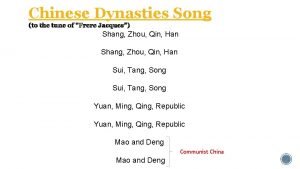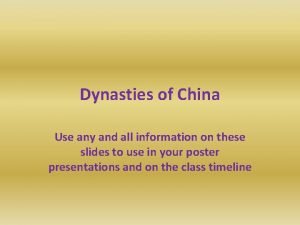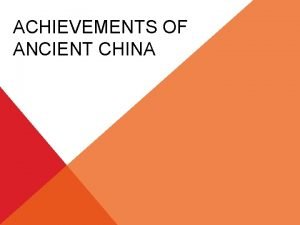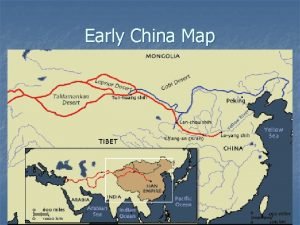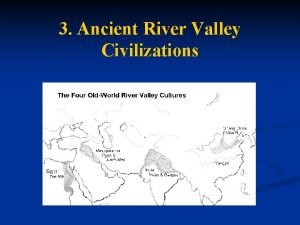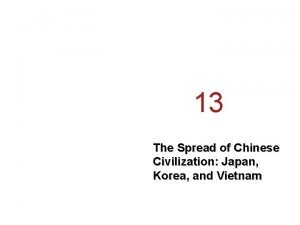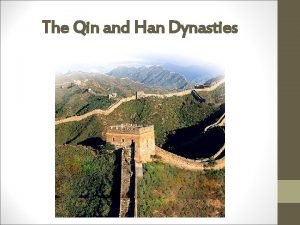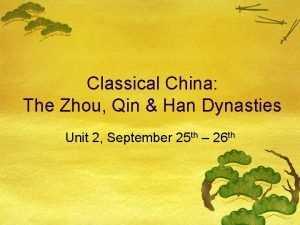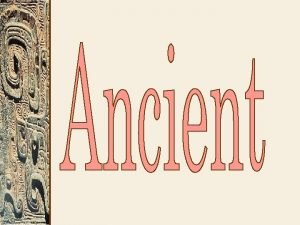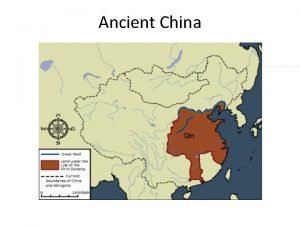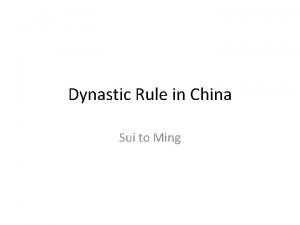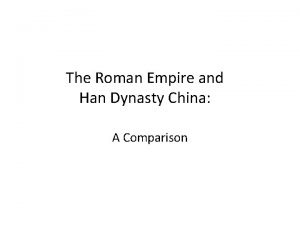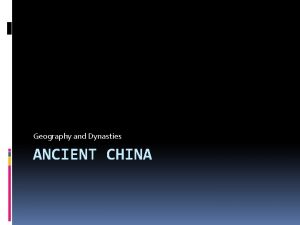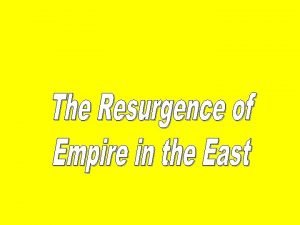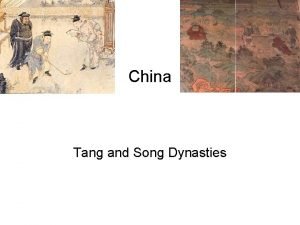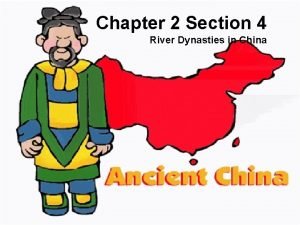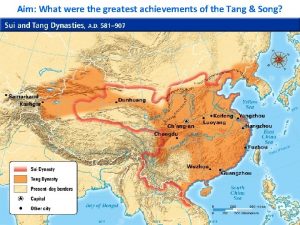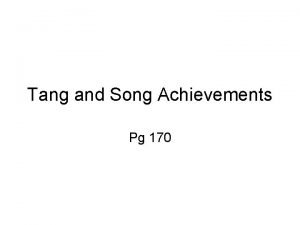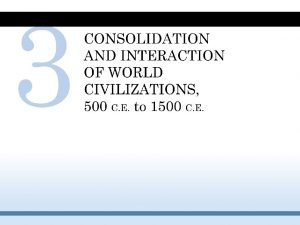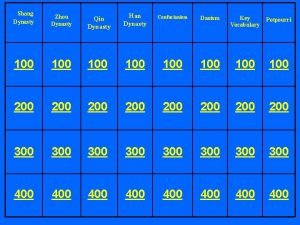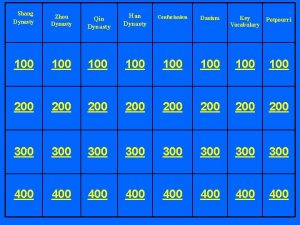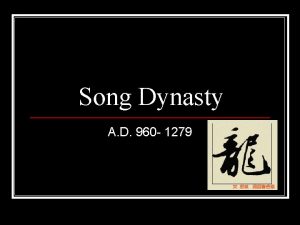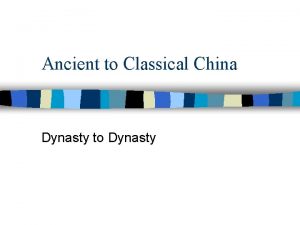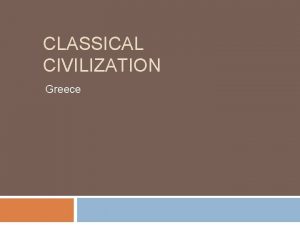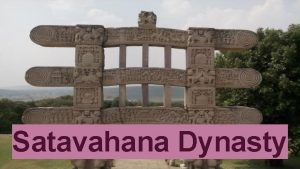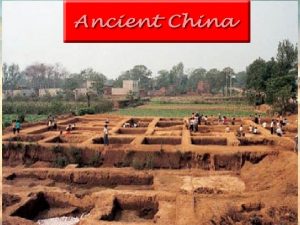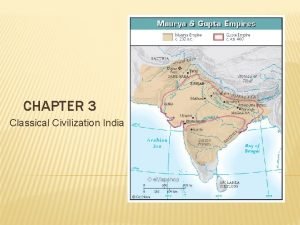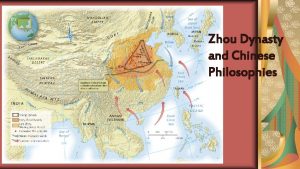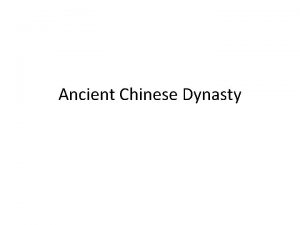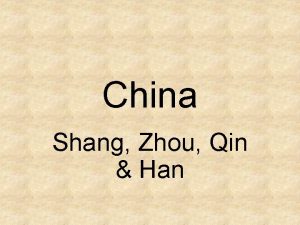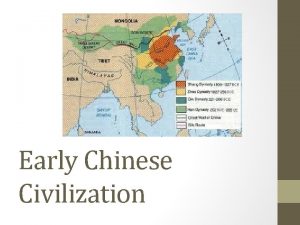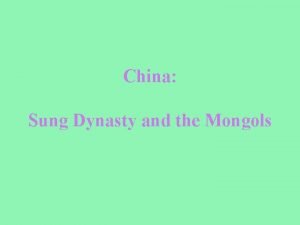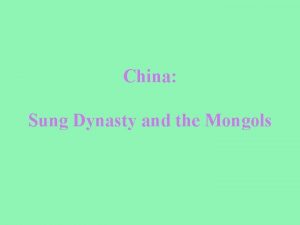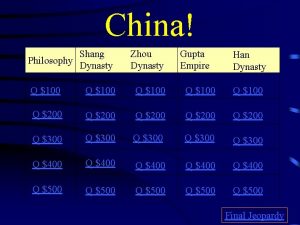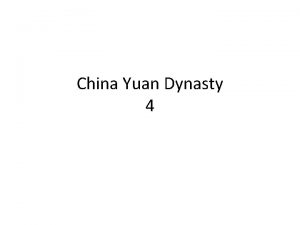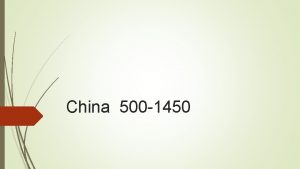Chapter 2 Classical Civilization China Chinese Dynasty Song




























- Slides: 28

Chapter 2 Classical Civilization: China

Chinese Dynasty Song • Using the tune Frere Jacques • Shang, Zhou (“Joe”), Qin (“chin”), Han • Sui (“swee”), Tang, Song • Yuan, Ming, Qing (“ching”), Republic • Mao Zedong, Mao Zedong • http: //www. youtube. com/watch? v=Xq. HR 1 u. Ac_-Q

Shang Dynasty (1600 -1046 BCE) First documented rule in China after Xia dynasty

Patterns in Classical China • 3 dynasties: Zhou, Qin, Han • Dynasty Cycle • When a dynasty begins, it usually emerges from a family of a successful general, or from a peasant rebellion • Over time, dynasties grew weak: • tax revenues declined • social divisions increased • Internal rebellions • periodic invasions • When one dynasty declines, another emerges

Zhou Dynasty 1029 -258 BCE • Displaced the Shang dynasty • Created the “Mandate of Heaven” • Used to justify rule based on the idea that Heaven transferred power of the dynasties and legitimized the current dynasty • Heaven would also be displeased with a poor leader and would cause that dynasty’s overthrow

Zhou Dynasty, cont. • Used feudalism to create alliances • Rulers gave land to family members, other noble families, and regional princes • In exchange, tax revenues and military troops were provided • Feudalism is unstable; depends on loyalties and obligations • Extended territory of China into the Yangtze River valley • Promoted one standard language (Mandarin Chinese)

Zhou Dynasty, cont. • Eventually, regional rulers formed independent armies • Great thinkers tried to restore order and social harmony through education • Zhou never established a powerful government and declined because of weak political infrastructure and nomadic invasions • Zhou dynasty ended after the Era of the Warring States (402201 BCE)

Zhou Dynasty

Qin Dynasty (221 -201 BCE) • Qin Shi Huangdi – only emperor of the Qin dynasty • Took control of feudal estates: knew the problem with Zhou dynasty laid with feudal nobles who ruled lands • Created non-aristocratic officials to oversee provinces • Had powerful army who crushed uprisings; brutal ruler

Qin Dynasty, cont. • Great Wall of China was begun • Over 3, 000 miles long • Built to protect from outside invasion • Largest construction project in human history • Built by forced labor, many died • National census • Calculate tax revenues and labor services more efficiently • Standardized coinage, weights and measures

Qin Dynasty, cont. • Uniform Chinese written script • Government supports agriculture with new irrigation projects • Shi Huangdi was very unpopular among Chinese citizens • Burned books • Taxed heavily • Large military expansion and conscription • After Shi Huangdi died, Qin dynasty ended

Han Dynasty (201 BCE-220 CE) • Developed examination system to prepare civil servants to work in government • Emperor Wu Ti worked to enforce peace, and required government to have formal training to emphasize Confucianism • Extensive expansion of Chinese territory • Trade routes led to contact with India, Parthian Empire, Roman Empire • Invasions by the Huns and a weak central government ended the dynasty • Between 220 -589 CE, China was in a state of chaos

Han Dynasty

Political Institutions in China • Most tightly governed of any large society in the world • Belief in desirability of central government • Power of the emperor • Shi Huangdi - single law code and uniform tax system • Qin and Han stressed central authority and strong government • Development of a educated, professional bureaucracy • Han create civil service tests • Expansion of state functions allowed government to reach the common people (ex: regulation of agricultural production to control costs) • Little emphasis on military since China did not depend on expansion to maintain its stability

Religion and Culture in China • Religion • Rulers in the Zhou dynasty maintained a belief in gods and stressed the importance of a harmonious earthly life • Ancestor worship • Philosophies/Ideologies • Confucianism • Legalism • Daoism/Taoism

Confucianism • Chinese ethical and philosophical system based on relationships and personal virtue • Developed from the teachings of Confucius (551 -478 BCE) on the eve of the Era of the Warring States • Based on Analects of Confucius • Confucianism spread throughout Classical China; predominant philosophy

Confucian Beliefs • Education • Self regulation • The proper exercise of political power by the rulers • Propriety and etiquette • Familial love and respect for parents • Righteousness • Honesty and trustworthiness • Loyalty to the state • Humaneness towards others • Highest Confucian virtue

Legalism • Qin and early Han periods • Strict system of obedience to government and law • Favors authoritarian state ruled by force (army to control people) • Human nature is evil and requires constant discipline • People’s responsibility to work for the government • Not successful in China overall, but influenced some policies and ideologies Shi Huangdi admired Legalist thinkers

Daoism • Founded by Lao Tzu (5 th c. BCE) • A more spiritual philosophy than Confucianism • Promoted humility, frugal living, simplicity • Harmony with nature, astrology • Secret rituals, ceremonies, mystery, magic • People should follow personal paths to self-knowledge • Little emphasis on formal education and learning • Many emperors favored Daoism

Economy in China • Large gaps between the upper class and the majority of people • Standardization of weights and measures by Qin facilitated trade • Focused on agriculture; virtues of peasants • Yangtze River Valley • wheat in north, rice in south • population growth

Trade in China • Extensive and regular internal trade using copper coins • Trade focused on luxury items: silk, jewelry, leather, furniture • Traded food between wheat and rice growing regions • Trade was not highly valued in Classical Chinese society (Confucian value of learning emphasized; merchants viewed poorly)

Technological Advances in China • Ox-drawn plows (300 BCE) • Collar created that did not choke the animal • Iron mining • Pulleys bring material to surface • Improved tools and weapons • Water-powered mills • Aided manufacturing • Paper • Allows government to keep records

Society in China • Social classes passed down through families • Not permanent; could move up • 3 social classes (hierarchical) 1. Landowning aristocracy and educated bureaucrats 2. Laboring masses: peasants and urban artisans • Manual labor • Produced manufactured goods (crops, etc. ) 3. Mean (average) people • People with unskilled jobs • Performing artists, merchants, household slaves • Punished more harshly than other groups

Families in China • Importance of unity and extended families • Power of husbands and fathers (patriarchy) • Power of parents • Children punished severely for disobedience • Ancestor worship • Role of women: power through sons, and as mother-in-law • Property rights: oldest male child inherited property

Science in China • Accurate calendar (444 BCE) • 365. 25 days • Adept at astronomy • Observed movements of Saturn and Jupiter • Developed early seismograph • Measures earthquake strength • Medical research • Principals of hygiene and anatomical knowledge

Chinese Art • Highly decorative, often representing nature • Chinese calligraphy • Artwork found on bronze, pottery, carved jade, ivory, woven silk screens • No monumental buildings or large monuments • Many palaces and tombs

Terracotta Army • Created around 210 BCE • Purpose: defend Shi Huangdi’s tomb, help him rule in the afterlife • Over 8, 000 individual soldiers, 130 chariots, 520 horses buried in four pits around the tomb • Terracotta: clay-based unglazed ceramic

 How did the ming dynasty restore chinese rule to china?
How did the ming dynasty restore chinese rule to china? Shang zhou qin han song
Shang zhou qin han song Xia dynasty government
Xia dynasty government Ancient china achievements
Ancient china achievements Chinese dynasty acrostic poem
Chinese dynasty acrostic poem Early china map
Early china map 4 river valley civilizations
4 river valley civilizations Chinese civilization map
Chinese civilization map Anglo chinese school primary
Anglo chinese school primary Four chinese dynasties
Four chinese dynasties Ancient china han
Ancient china han Zhou
Zhou Princess anle
Princess anle China zhou dynasty
China zhou dynasty Zhou dynasty wars
Zhou dynasty wars How did the sui dynasty affect daily life in china
How did the sui dynasty affect daily life in china Dynasty vs empire
Dynasty vs empire Sui tang and song dynasties
Sui tang and song dynasties Chinese dynasties
Chinese dynasties China dynasty
China dynasty Tang and song china chapter 12 section 1
Tang and song china chapter 12 section 1 Song dynasty social structure
Song dynasty social structure Buddhism and chinese culture
Buddhism and chinese culture Qing social structure
Qing social structure Tang and song dynasty venn diagram
Tang and song dynasty venn diagram Zhou dynasty social pyramid
Zhou dynasty social pyramid Empress wu accomplishments
Empress wu accomplishments Tang and song dynasty achievements
Tang and song dynasty achievements Combulac
Combulac

